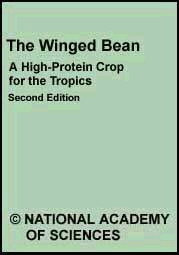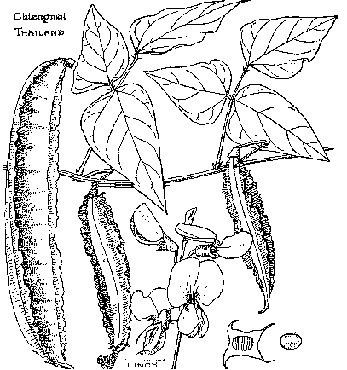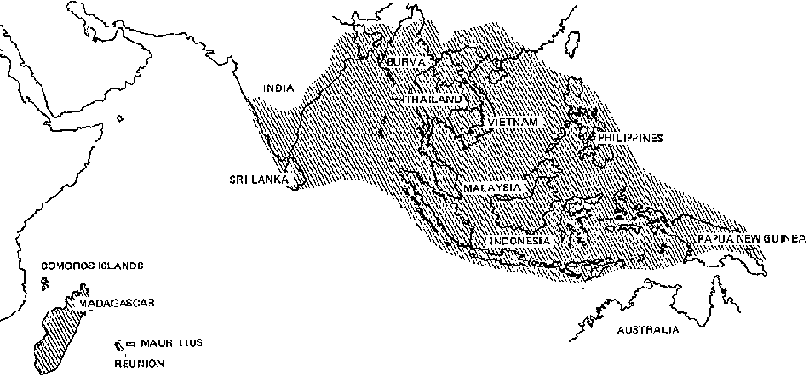
Agronomy[edit | edit source]
The winged bean is a climbing, herbaceous perennial. Most varieties if supported can reach heights of 3-4 m.
Stems are usually green, but some varieties have stems with shadings of purple, pink, or brown. Flower colors are usually blue, bluish white, or purple, but the range of possible colors varies from near white to deep purple.
Pods are four-cornered and rectangular or square in cross section, with wings at each corner. A few are essentially square, some are flat and broadest on the sutured surfaces (sutured surfaces are the ones that automatically split when the pod opens), and others are flat and broadest on the non-sutured surfaces. The pods can be 6-66 cm long. Pod colors range from green-the most common color - to pink, red, or purple. Some have wings of a different color than the pod itself. Wings may be wavy, serrated, or lobed.
Individual pods contain from 5 to 20 seeds. The seeds, shiny and globular, range in weight from 0.04 to 0.64 g. Depending on variety, seeds may be cream colored, greenish, various shades of brown, deep purple, black, or mottled.
The winged bean is largely self-pollinating, but bees visit the flowers and as much as 20 percent cross-pollination has been noted.
The pods develop in two stages. In the first, which takes about 20 days, the pod grows to almost its ultimate size. In the second, which takes about 44 days, the seeds swell and harden, while the surrounding pod shrivels, hardens, and dries out.
Pods can be ha vested as a green vegetable early in the first stage, before much fiber forms. They can be gathered early in the second stage and shelled like peas to yield the soft, green, unripe seeds, or, after the pod has dried, they can be harvested for the hard, mature seeds.
Dried pods have a tendency to split open unexpectedly and drop the seeds on the ground. However, non shattering types are known.
Psophocarpus tetragonolobus: winged bean. Leaves, inflorescente with pale blue flowers and buds, and young and mature pods. The insets on the right are of a cross section of an old pod and seed. (Based on a drawing by G.A.C. Herklots)
Taxonomy
Psophocarpus is a genus with about nine species. All but the winged bean, P. tetragonolobus, appear to be indigenous to Africa. Only P. tetragonolobus and P. palustris have been used for food. The other species have never been cultivated. Even P. palustris remains a semiwild plant, used in West Africa mainly in times of famine.
Native Habitat
The winged bean's origin remains in dispute. At least four sites have been suggested as possibilities: Papua New Guinea, Mauritius, Madagascar (the Malagasy Republic), and India. Centers of greatest diversity of the species are Papua New Guinea and Indonesia, although increasing numbers of varieties have recently been discovered in Thailand and Bangladesh.
The winged bean has been cultivated for generations in the humid tropics of South and Southeast Asia: India, Sri Lanka, Bangladesh, Burma, Malaysia, Thailand, Vietnam, Laos, Cambodia, the Philippines, Indonesia, and Papua New Guinea, for example. In South Asia it is cultivated in Bangladesh, in at least eight Indian states extending from the north to the south, and in Sri Lanka, where it has been grown for generations in the wet zone as well as in the dry zone regions up to an elevation of 1,000 m.
In Papua New Guinea the winged bean is an important backyard and market crop in the Highlands and in the north coast provinces. The number of varieties and their use in certain tribal rites suggest that the winged bean has been cultivated in Papua New Guinea for centuries. The villagers differentiate varieties that produce high tuber yield from those that produce large amounts of pods. In some areas winged bean tubers are an important staple, but in most areas they are a seasonal food.
In Papua New Guinea, Burma, and now in Thailand, the winged bean is grown as a field crop. In virtually every other country where it is grown, it is a crop planted by the farmer or homeowner for his own use along the rice field borders, hedges, roadside fences, or in the backyard garden against the house or a nearby tree.
Biological Variation
Recent collections of winged beans in different parts of Asia have demonstrated wide differences in many physical features: leaf shape and size; flower color; pod length, shape, and color; wing shape and surface texture; seed shape, size, and color; tuber size; and stem colon There are also physiological differences: the time required for seeds to germinate, flowers to form, pods to set, seeds to mature, and tubers to form. In addition, there are variations in the protein, oil, and other components of the seeds and other parts of the plant.
With the growing interest in, and work on, the winged bean, many hitherto unrecorded types have been located in Asian countries, including Bangladesh, Sri Lanka, Thailand, and Indonesia. The newly assembled collections include more than 500 winged bean types in Thailand, 200 in Bangladesh, and more than 100 in Indonesia. The actual number of varieties grown by Asian farmers, however, is not known.
Home territory of the winged bean.
Environmental Requirements
Latitude The winged bean has traditionally been cultivated between latitudes of 20°N (Bangladesh, northern Thailand, and northern Burma) and 10°S (Melanesia and the Comoro Islands). However, in recent years the plant has been successfully introduced to subtropical and warm temperate latitudes. For example, plants are flourishing in Florida (in Gainesville, 29°N and Homestead, 25°N); Taiwan, 25°N; Western Australia (Perth, 32°S); and Queensland (Brisbane, 27°S).
In Thailand a few plants have been noticed flowering out of season, and these apparently day-length-neutral plants suggest that types can be found that will flower and yield seeds in temperate areas.
Altitude The plant is grown at sea level in many places and up to 2,200 m in the Highlands of Papua New Guinea. However, trials there have shown that germination and growth were poor, and flowering delayed, at altitudes of 1,600 m (at Wapenamunda) or above.
Rainfall For good growth the plant requires ample and well-distributed moisture. It is traditionally cultivated in areas with annual rainfall of 7004,000 mm. It thrives in hot, humid areas with 2,500 mm or more of annual rainfall.
The winged bean also displays some drought tolerance. In 1979 Thailand had its worst drought in history. Cornfields died but winged bean fields survived, although most plants did not grow well (the plants flowered poorly and the rhizobia perished). A few apparently drought-tolerant plants, however, did survive and yielded satisfactorily. Some drought-resistant specimens have also been observed in India.
Soil The winged bean appears to tolerate a wide range of soil conditions. It grows well in soils with low organic matter and in sandy loams or heavy clays. It does not do well in very alkaline or very acid soils. Its "ideal" pH limits are given as low as 5.5 and 4.3. (On acid soils, however, the plant is susceptible to aluminum toxicity.) In Homestead, Florida, most winged bean specimens thrive with a soil pH of 8.0.* Although in most areas farmers do not fertilize before planting winged bean, the plant responds well to potassium and phosphorus fertilization.
Temperature The winged bean withstands high temperatures but almost never survives frost. Temperature is as important as day length in controlling flowering. Continuous day temperatures higher than 32°C or lower than 18°C inhibit flowering even under otherwise suitable short-day conditions.
Cultivation
Winged beans are grown mainly in small plots: subsistence or backyard gardens, the edges of fields, and against fences or walls. They are generally sown at the beginning of the wet season. Scarification is usually unnecessary. In moist soil the seeds swell within 4-5 days and germinate within 7-10 days. However, some researchers scarify the seeds between sheets of fine sandpaper, or soak them overnight in water or dilute sulfuric acid to make them germinate even more quickly and uniformly.
In many countries spacing of about 1 m between rows and 25-70 cm between plants is recommended. In Papua New Guinea planting densities in the order of 125,000-150,000 plants per hectare are reported to give best pod and seed yields. Seeds are planted at a depth of 2-3 cm.
Staking the crop increases yields. In Nigeria staking more than doubled the yield of pods and seeds. In Malaysia staking was found to increase both seed and tuber yield. Stakes or trellises' 1.2-2 m tall, are generally used. Supports can be made of bamboo, wire, string, or pipe. Research is underway on the use of living plant supports such as fruit trees, leucaena, and Sesbania bispinosa. Thai researchers have had initial success with planting corn and winged bean together: the corn crop matures first and can be harvested; the winged bean then uses the corn stalks as support.
Most winged bean varieties are sensitive to day length. They set flowers only when days are short. When sown at this time, they can flower very quickly (4 weeks or less), even when the plants are small; at other seasons they may flower only after many months, when day length becomes suitable.
In Sri Lanka and Bangladesh, in contrast to most of Southeast Asia, the plant is treated as a perennial and allowed to regenerate from the underground parts for at last three successive seasons before seeds are planted again. In other countries the crop is treated as an annual and seeds are planted each year.
In the first month of cultivation, weeds must be controlled. Once established among the young plants, weeds become entwined and are difficult to remove.
Yield
Seed The winged bean seems capable of producing exceptional amounts of seed. There are at least 7 reports of yields of more than 2 tons of seed per hectare.* In experimental plots in Papua New Guinea, a yield in excess of 2 tons of seed per hectare is considered quite common. There has been at least one report of seed yield of more than 3 tons per hectare and one record of a yield of more than 4 tons per hectare. § All these measurements, it should be emphasized, are extrapolated from small plots. The only large-scale commercial cultivation is in Thailand and the largest existing stand is about 25 hectares. In 19790- the drought year mentioned above-yields were only 600-1,400 kg per hectare in these fields.
TABLE 1. Yield of Edible Parts of the Winged Beana
|
Greatest Yields Reportedb (kg/ha) | |
|
Immature pods |
34,700c - 35,500d |
|
Ripe seeds |
2,000e - 5,000f |
|
Tubers |
5,500 - 11,700g |
a Table based on Khan and Eagleton, 1978.
b Data based on Martin, 1980; Khan et al., 1977;Wong, 1976;Herath, 1980; Karikari, 1980; Khan and Erskine, 1978; Odor, 1980, Rachie 1974, and Robertson et al., 1980. Tuber yield is from farmers' plots; other yields are experimental.
c Jiminez, 1976. Measure is for fresh weight.
d Wong, 1975. Measure is for fresh weight.
e Khan, 1976.
f Khan, communication, 1979. Measure is for fresh weight.
g Khan et al., 1977. High yield was for harvesting UPS 122 on a farmer´ field in Mt. Hagen in the Papua New Guinea Highlands. Similar estimates were obtained from subsistence gardens. Stephenson, unpublished communication, 1979.
Pods
Yields reported for the green (immature) pods harvested as a fresh vegetable range up to 35 tons per hectare.!
Tubers
A field of tubers grown in the traditional manner by village farmers in the Highlands of Papua New Guinea yielded the equivalent of 11.7 tons per hectare."
Nodulation
The winged bean can develop large numbers of nitrogen-fxing root nodules, apparently often exceeding the number formed on other legumes. In Thailand as many as 1,000 nodules have been counted on a single plant.
The high protein content in the seeds, pods, leaves, and tubers is probably caused by the plant's exceptional capacity to fix nitrogen. Most tropical soils evidently contain rhizobia suitable for inoculating the winged bean. Excellent nodulation without any need for inoculation appears to take place every" where the crop has been grown. The bacteria involved are common Rhizobium types that inoculate many wild legumes and are sometimes spoken of as belonging to the cowpea group.
Tuber Production
Several winged bean varieties form tubers. Three tuber-forming varieties recorded in Indonesia and Nigeria do not flower under local conditions; in such cases the varieties are reproduced from the tubers themselves.
Although ability to form tubers seems to depend primarily on the genetic variety, it is also affected by environmental factors such as temperature, day length, and certain cultivation practices. Many varieties, if left in the ground, will grow a new crop from the tubers.
When grown for tubers in Burma, the winged bean plants are spaced 1020 cm apart and allowed to trail on the ground. In other countries where the tuber is cultivated, the plant is grown on stakes somewhat shorter in length than those used when cultivating the plant for pods or seeds. Tubers are harvested from 5 to 12 months after sowing, depending upon variety, environmental factors, and cultivation practices. They are usually then 2-4 cm in diameter and about 8-12 cm long.
Use as Cover Crop
In Ghana the winged bean has proved particularly effective as a cover crop to protect the soil beneath plantation crops. It establishes well in comparatively poor soils, grows densely, crowds out weeds, and provides the plantation farmer with a source of food.* Although it tends to climb up the trees, it has been tested successfully in coconut, banana, oil palm, rubber, and cacao plantations. (The small-leafed P. palustris reportedly grows well as a ground cover and has been used in plantations in both Sri Lanka and Malaysia.)

